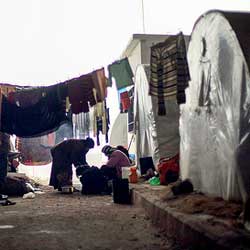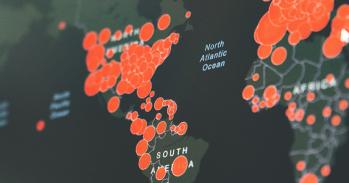
A new study is looking at a century of mass migrations worldwide to understand the public health consequences when people are forced to flee from war, persecution and natural disaster.
A new study is looking at a century of mass migrations worldwide to understand the public health consequences when people are forced to flee from war, persecution and natural disaster.
Since biblical times, mass migrations have followed conflict and crises
Professor Andy Cliff
As the humanitarian crisis in Syria continues to unfold, over two million people are thought to have crossed the borders into neighbouring countries. Desperate, empty-handed and facing an uncertain future, most of the refugees will seek aid and support in camps, where they will be exposed to yet another threat: infectious disease.
High population densities, malnutrition, poor sanitation, sexual violence and reduced access to healthcare following forced migration can create a ‘perfect storm’ where communicable diseases become a major cause of mortality and morbidity. And it’s far from a recent problem.
Over 600,000 cases of cholera have been recorded in Haiti since the earthquake of 2010, which displaced up to 2.3 million people. Cholera was also responsible for some 50,000 deaths in 1994 among refugees of the Rwandan genocide. In 1949, the British Red Cross noted that malaria and dysentery were widespread among 30,000 Arab refugees living in huts, caves or ragged tents in Jordan. In 1901, Boer War refugees were exposed to measles, pneumonia, dysentery, diarrhoea, bronchitis and enteric fever in the camps of the Transvaal.
“Since biblical times, mass migrations have followed conflict and crises,” said Professor Andy Cliff. “Today, humanitarian aid organisations perform an incredible job in taking care of refugees but this can take time to come into play, and the conditions that migrants find themselves in raises the spectre of epidemics. Diseases such as cholera, dysentery, measles and meningitis, for instance, have resulted in high mortality rates in relief camps in Africa, Asia and Central America.”
Although the impact of forced migration on health is well known, no study has ever systematically linked the nature of displacement, its geographical location and the particular patterns of disease that occur: a triangulation that, if charted, could help authorities and aid agencies prepare as crises unfold.
"We call this the displacement–disease nexus,” added Cliff. “Understanding it lies at the heart of preparing for future displacements, both for the welfare of the migrants and for the health and economy of the destination.”
For the past year, Cliff from the Department of Geography and Professor Matthew Smallman-Raynor from the University of Nottingham have been leading a project that is assembling the first ever database to link these types of information. And to do so, their team is looking back over 100 years of forced migrations, across the globe.
“The research could scarcely be more timely,” said Smallman-Raynor. “The most recent figures released by the Office of the United Nations High Commissioner for Refugees (UNHCR) estimate up to 45.2 million people in situations of displacement for 2012, which is the highest figure in 20 years.”
Cliff’s colleagues Dr Anna Barford and Heather Hooper have begun the task of hunting through the rich archives held by organisations such as the UNHCR, the International Committee of the Red Cross, the United Nations Office at Geneva and the World Health Organization, as well as searching through scientific journals dating back to 1901. A doctoral student, Anna-Meagan Fairley at the University of Nottingham, is looking specifically at infectious disease among people displaced by natural disasters.
“Because each set of circumstances is unique, we need to look at as many cases of displacement as possible, over a long time period,” said Barford. “Only then can we start to work out whether there are patterns that governments and aid agencies can learn from in preventing epidemics and delivering healthcare.”
Epidemics of communicable diseases not only affect the health of migrants in camps, but also the health of those in areas the migrants pass through during their migration. “Perhaps one of the most significant examples relates to the First World War,” said Cliff. “Chaos ensued in terms of preparedness for the end of the war – several million refugees were swilling around on borders between Russia and eastern Europe, and you could map the spread of typhus and cholera marching with the refugees as they crisscrossed Europe.”
The results will be used to establish global electronic databases of infectious disease events in relation to mass population movements since the beginning of the 20th century. “It will be a fascinating resource,” said Barford. “Out of this we’ll pick 50 events and look in detail at the short-, medium- and long-term geographical patterns and consequences of displacement-associated epidemics. The databases will be available to national and international organisations involved in health promotion and in the delivery of humanitarian assistance.”
The results will also be published by Oxford University Press as one of a series of atlases; a previous volume in the series Atlas of Epidemic Britain: A Twentieth Century Picture authored by Cliff and Smallman-Raynor won the British Medical Association prize for Best Medical Book of the Year 2013.
The results of this ambitious project, which is funded by the Leverhulme Trust, will also be of interest to countries such as the UK that eventually become home to refugees after they have left intermediary camps. “This so-called secondary migration has been the cause of much public and political debate, with the UK’s Department of Health launching a consultation into proposals for charging migrants to use the health system,” added Cliff. “By also looking at the long-term health consequences for secondary migrants, we hope to shed light on how best to prepare for their arrival and support their healthcare.”
For further information about this story, please contact Louise Walsh at louise.walsh@admin.cam.ac.uk
Inset image: A Syrian woman near a fire at a refugee camp in Azaz, Syria, on December 17, 2012. Credit: Freedom House
Migration and mental health
Infectious disease is not the only health threat that victims of forced migration face. Their mental health is also at risk.
Forced migrations are often the result of violent events or economic hardship, which can have profound psychological consequences. Migrants may be without their family support network and living in difficult conditions, while their left-behind families might find it equally hard to cope.
The mental health of individuals after forced migration, as well as after their subsequent return migration, is an area that Dr Tine Van Bortel from the University’s Institute of Public Health describes as “one of the least explored areas of health research.”
She has been involved in pilot projects that have looked at the quality of life, well-being and mental health of migrant domestic workers and their left-behind families in Singapore and Sri Lanka, and of Muslims forcibly resettled in 1990 by rebel fighters in Sri Lanka, working in collaboration with Dr Chesmal Siriwardhana and Sabrina Anjara at King’s College London and researchers at the Sri Lankan Institute of Research and Development (IRD).
“In terms of economic forced migration, we find that both labour-receiving countries and labour-sending countries have inadequate measures to provide the information, care and support that’s needed for migrant workers and their left-behind families,” said Van Bortel. “Some labour-receiving countries have health checks in place but these focus mainly on communicable diseases and not on mental health. Hard work, social isolation, abuse and missing their left-behind family members often lead to significant mental strain and sometimes suicide. In turn, the left-behind families often find it difficult to cope too."
“We are now broadening our research to look at possible interventions to raise awareness, psycho-educate and empower people to make more informed decisions about economic migration, to help migrant workers and their left-behind families cope more constructively with often challenging situations, and to address the psycho-social needs of displaced populations,” added Van Bortel.
“Humanitarian agencies are increasingly aware of the psychological consequences of forced migration and have been campaigning for change. We hope that the results might be used by legislators and policy makers in countries affected by forced migration and internal displacement to improve policy and practice for the benefit of individuals, families and communities.”
This work is licensed under a Creative Commons Licence. If you use this content on your site please link back to this page.





